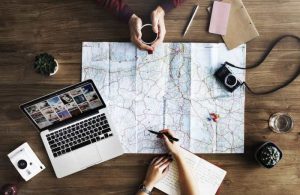
The open road beckons, promising adventure, discovery, and a chance to escape the everyday. A road trip across the United States is an experience that can transform your perspective, create lasting memories, and leave you with a renewed sense of wonder. Whether you’re seeking breathtaking landscapes, iconic landmarks, or simply the freedom of the journey itself, planning a cross-country road trip requires careful consideration.
This guide provides a comprehensive framework, covering everything from route planning to travel essentials, ensuring a smooth and unforgettable adventure.
From the rugged mountains of the West to the sun-drenched beaches of the East, the United States offers a diverse tapestry of experiences waiting to be explored. With meticulous planning and a spirit of adventure, you can embark on a road trip that will forever etch itself into your memory.
Activities & Attractions
Planning a road trip across the United States is an exciting adventure that allows you to experience the country’s diverse landscapes, vibrant cities, and rich history. From iconic landmarks to hidden gems, there’s something for everyone along the way.
Popular Tourist Attractions
Choosing your route is key to maximizing your experience. You can select a classic route like Route 66, the Pacific Coast Highway, or a cross-country drive from coast to coast. Each route offers unique attractions and experiences. Popular tourist attractions include:
- National Parks: The United States boasts a network of stunning national parks, each with its own unique beauty. From the towering redwoods of Redwood National Park in California to the geysers of Yellowstone National Park in Wyoming and Montana, there’s something for everyone.
- Iconic Landmarks: The Statue of Liberty in New York City, the Golden Gate Bridge in San Francisco, and the Grand Canyon in Arizona are just a few of the iconic landmarks that attract millions of visitors each year.
- Historical Sites: The United States is rich in history, and there are countless historical sites to explore. From the Gettysburg National Military Park in Pennsylvania to the Alamo in Texas, these sites offer a glimpse into the country’s past.
- Major Cities: Cities like New York, Los Angeles, Chicago, and San Francisco offer a wealth of attractions, from world-class museums and theaters to vibrant nightlife and shopping.
Unique and Off-the-Beaten-Path Experiences
For those seeking a more unique and off-the-beaten-path experience, there are countless hidden gems to discover.
- Small Towns and Villages: Small towns and villages often hold a charm that larger cities lack. Explore local shops, restaurants, and museums, and experience the slower pace of life.
- National Forests and Wilderness Areas: Escape the hustle and bustle of city life and immerse yourself in the beauty of nature. Go hiking, camping, fishing, or simply enjoy the tranquility of the wilderness.
- Local Festivals and Events: Research local events, such as festivals, concerts, and farmers markets, to experience the culture and traditions of the region.
- Roadside Attractions: From giant statues to quirky museums, roadside attractions offer a glimpse into the unique and often humorous side of Americana.
Planning Activities for Each Destination
Planning your activities in advance is crucial for maximizing your time and ensuring you don’t miss out on any must-see attractions.
- Research and Planning: Use online resources such as travel websites, guidebooks, and local tourism boards to research attractions, events, and activities.
- Create an Itinerary: Develop a flexible itinerary that allows for spontaneity while ensuring you see the highlights of each destination.
- Book Accommodations: Book your accommodations in advance, especially if you’re traveling during peak season or visiting popular destinations.
- Consider Local Events: Check for local events, such as festivals, concerts, and sporting events, to add an extra layer of excitement to your trip.
- Cultural Experiences: Immerse yourself in the local culture by visiting museums, art galleries, and historical sites. Try local cuisine and learn about the region’s history and traditions.
- Outdoor Adventures: If you enjoy outdoor activities, consider hiking, biking, kayaking, or exploring the local parks and wilderness areas.
Recommended Resources
To enhance your road trip experience and learn more about the destinations, consider exploring these resources:
- Books: “The Ultimate Guide to Road Trips Across America” by Rick Steves, “The Road Less Traveled” by Robert Frost, “On the Road” by Jack Kerouac.
- Podcasts: “The Road Trip” by Atlas Obscura, “The History of the Road” by The Smithsonian, “The Great American Road Trip” by NPR.
- Documentaries: “America’s National Parks” by PBS, “The American Road” by National Geographic, “Route 66: The Mother Road” by History Channel.
Travel Essentials & Safety

A well-planned road trip across the United States requires careful consideration of essential items and safety precautions. This section will guide you on packing essentials, staying safe on the road, managing travel documents, and staying connected while exploring the vast landscapes of America.
Packing Essentials
A comprehensive packing list is crucial for a comfortable and enjoyable road trip. It’s essential to pack for various weather conditions, potential emergencies, and personal needs.
- Clothing: Pack a variety of clothing items suitable for different weather conditions, including warm layers, rain gear, and comfortable shoes for walking and hiking.
- Toiletries: Include essential toiletries like shampoo, conditioner, soap, toothpaste, toothbrush, sunscreen, insect repellent, and hand sanitizer.
- Medications: Pack all necessary medications, including prescription drugs, over-the-counter medications, and first-aid supplies. Remember to bring enough for the duration of your trip and carry a copy of your prescription.
- Electronics: Pack chargers for your phone, laptop, and other electronic devices. Consider a portable power bank for charging on the go.
- Entertainment: Pack books, magazines, music, or podcasts to keep yourself entertained during long drives.
- Other Essentials: Include a flashlight, a multi-tool, a small toolkit, a map, and a travel guide.
Travel Safety Tips
Road safety is paramount during a long road trip. It’s essential to be aware of your surroundings, drive responsibly, and take precautions to ensure a safe journey.
- Drive Responsibly: Follow traffic rules, avoid distractions, and take breaks every few hours to prevent fatigue.
- Be Aware of Surroundings: Pay attention to your surroundings, especially when parking or stopping at rest areas. Be cautious of your belongings and avoid leaving valuables in plain sight.
- Stay Informed: Check weather forecasts and road conditions before starting your journey. Monitor traffic updates and be prepared for potential delays.
- Vehicle Maintenance: Ensure your vehicle is in good working condition before starting your trip. Check tire pressure, fluid levels, and overall vehicle health.
- Emergency Kit: Pack a basic emergency kit that includes a first-aid kit, a flashlight, a blanket, jumper cables, and a basic toolkit.
Managing Travel Documents
Properly managing travel documents is crucial for a smooth journey. Ensure you have all necessary documents readily available and organized.
- Driver’s License: Keep your driver’s license and vehicle registration documents in a safe and accessible place.
- Insurance: Carry your vehicle insurance information, including policy number and contact details.
- Passport: If traveling internationally, ensure your passport is valid for at least six months beyond your planned return date.
- Visa: If required, obtain the necessary visa for your destination country.
- Travel Itinerary: Keep a copy of your travel itinerary, including flight details, hotel reservations, and planned activities.
Staying Connected While Traveling
Staying connected while on the road is essential for communication, navigation, and accessing information. Consider using a combination of mobile devices, Wi-Fi hotspots, and travel apps.
- Mobile Devices: Ensure your mobile device has sufficient data or a suitable roaming plan. Consider using a travel SIM card for international travel.
- Wi-Fi Hotspots: Look for free Wi-Fi hotspots at hotels, restaurants, cafes, and public libraries.
- Travel Apps: Utilize travel apps for navigation, finding gas stations, restaurants, and attractions.
- Satellite Communication: In remote areas with limited cellular coverage, consider using satellite communication devices for emergency contact and data access.
The Travel Experience

A road trip across the United States is more than just a journey from point A to point B. It’s an immersive experience that allows you to connect with the vastness of the country, discover hidden gems, and create memories that will last a lifetime.
Unexpected Encounters
Road trips often lead to unexpected encounters that enrich the journey. You might stumble upon a charming local festival, meet friendly locals who share their stories, or even witness breathtaking natural phenomena. Embrace these unplanned moments, as they often become the most memorable parts of your trip.
Scenic Views
The United States boasts an incredible array of landscapes, from towering mountains and vast deserts to sparkling coastlines and lush forests. Take advantage of scenic overlooks and pull-off points to soak in the beauty of your surroundings. Capture these moments with photographs, sketches, or simply savor the experience.
Personal Growth
A road trip can be a transformative experience, allowing you to disconnect from your daily routine and reconnect with yourself. The freedom of the open road, the challenges you encounter, and the new perspectives you gain can foster personal growth and self-discovery.
Documenting the Journey
Capturing the memories of your road trip is essential. Consider these methods:
- Photography: Use your camera or smartphone to capture the landscapes, landmarks, and moments that resonate with you. Don’t forget to include portraits of yourself and your travel companions.
- Travel Journal: Write down your thoughts, feelings, and experiences as you travel. Include details about the places you visit, the people you meet, and the challenges you overcome.
- Video Log: Create a video diary of your journey, capturing the sights, sounds, and stories along the way. Share your experiences with friends and family, or even create a travel vlog to inspire others.
Benefits of a Road Trip
Embarking on a road trip offers numerous benefits, including:
- Exploring New Places: A road trip allows you to discover hidden gems and off-the-beaten-path destinations that you might miss on a traditional vacation.
- Connecting with Nature: Driving through diverse landscapes allows you to experience the beauty and grandeur of nature firsthand.
- Fostering Personal Growth: The challenges and experiences of a road trip can help you develop new skills, build resilience, and gain a deeper understanding of yourself.
A road trip across the United States is more than just a journey; it’s an odyssey of discovery, a tapestry woven with breathtaking landscapes, unforgettable encounters, and the thrill of the open road. As you navigate the winding highways and explore hidden gems, you’ll forge memories that will last a lifetime. Remember, the journey is as important as the destination, so embrace the unexpected, savor every moment, and let the spirit of adventure guide your way.
Answers to Common Questions
What is the best time of year to take a road trip across the United States?
The best time depends on your preferences. Spring and fall offer pleasant weather in most regions, while summer brings peak season and crowds. Winter can be beautiful but requires careful planning for potential snow and ice.
How long does it take to drive across the United States?
Driving time varies greatly depending on your route and stops. A direct route across the country can take around 3-4 days, but allowing time for sightseeing and detours can extend the trip to several weeks.
What are some must-see destinations on a road trip across the United States?
Must-see destinations vary based on your interests, but popular choices include the Grand Canyon, Yosemite National Park, Route 66, the Great Smoky Mountains, and the Florida Keys.
How much does a road trip across the United States cost?
The cost can vary significantly depending on your travel style, accommodation choices, and activities. It’s essential to create a budget and factor in gas, food, lodging, and entertainment expenses.



